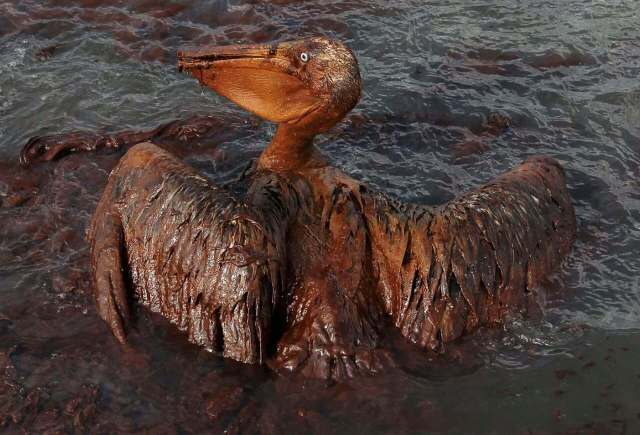The adage "a picture is worth a thousand words" is so often repeated that it feels commonplace.
Yet a shocking photo series of oil-soaked pelicans during the Deepwater Horizon oil spill, one of the worst environmental disasters in U.S. history, was anything but ordinary, galvanizing recovery efforts off the coast of Louisiana.
What is the Deepwater Horizon oil spill?
On April 20, 2010, an oil drilling rig exploded, killing 11 people, injuring 17, and dumping millions of gallons of crude oil into the Gulf of Mexico, as detailed by Riley Farrell of BBC Future.
Through the next 87 days, oil continued to contaminate the waters, with the Environmental Protection Agency (EPA) noting that 4 million barrels flowed into an ecosystem known for its vibrant wildlife, including Louisiana's state bird, the brown pelican.
Like numerous other creatures, the pelicans — taken off the endangered species list just a few months prior, per the BBC — were covered in petroleum and a toxic chemical that broke down the oil.
Win McNamee, the lead photographer for Getty Images, documented those pelicans' struggles.
Why were the pelican photos important?
When McNamee's photos were published by multiple major outlets, including CNN and National Geographic, the visuals helped the public, researchers, and policymakers to deeply connect with the plight of the pelicans and other creatures killed by the oil.
According to the BBC, this new mass awareness upped the pressure to resolve the oil leak, which killed thousands of birds, including an estimated 10% of all brown pelicans in the northern Gulf of Mexico, and even negatively affected their DNA.
"[The] photos don't capture the scale of the issue, but they tell the tragic story," Erik Johnson, the director of conservation science at Audubon Delta, told the BBC.
"We are social creatures. We connected with this intimate portrait," Johnson added.

How the photos could help future environmental efforts
Johnson noted the photos sparked interest in conservation from a whole new group of people.
"You look at these pictures, you get angry. That is a trigger for people to want change: social change, environmental change, policy change," he told the BBC, adding that it "will make the Gulf Coast more resilient in the long term."
Following the oil spill, the U.S. government created the Bureau of Safety and Environmental Enforcement. Prior to the development of the bureau, an agency that approved leases for oil companies was also responsible for regulatory enforcement, per the BBC.
The bureau's formation was an important preventative step to protect human life from the toxic chemicals in the oil.
Has the area recovered?
While the negative environmental impact of the spill is still evident, there are promising indications of recovery, according to WaterMarks.
Johnson added that he's "happy" the ecosystem didn't suffer a "complete collapse," aided in part by more than $5 billion of restoration funds, per the BBC.
Another sign of hope? In 2021, one of 582 brown pelicans rescued from the spill famously traveled 700 miles back home to Louisiana.
Join our free newsletter for cool news and cool tips that make it easy to help yourself while helping the planet.









